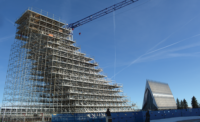Competition has caused many contractors to be careful about what they will bid on. “We spend a great deal of time talking about our risk-assessment tools and being vigilant from a pricing perspective. We’re proud of the expertise we have and the value it can bring to a project. It has allowed us to remain competitive in the projects we pursue,” says Tim Chadwick, CEO of MMC Corp.
Owners increasingly are embracing the growing trend of alternate project delivery, integrating subcontractors into the contracting team earlier in the building process. This trend indicates that owners “are recognizing the value of bringing specialty contractors on board early, during preconstruction, so that they can maximize the use of lean methods [such as] BIM-enabled prefabrication and modular building components,” says John Cannistraro Jr., president of J.C. Cannistraro LLC.
This trend is no longer limited to a few key specialties. “The mechanical and curtain-wall trades have been part of the coordination process for a long time, but that is now happening in the drywall and ceiling trades,” says Chris McPherson, COO of Central Ceilings Inc. He says being at the table together earlier in the process strengthens project teams and relationships, dramatically improving the end product.
This cooperation is an abrupt shift from earlier in the recession, when price was king and contractors scrambled to save money any way they could. “The days of long, drawn-out bidding and re-pricing multiple times—both to the customer and from your vendors—are behind us for now,” says Jeffrey Haber, managing partner at W&W Glass LLC. In this new collaborative world, “there is no time to play the old-style games that we were all subject to during the downturn four to six years ago,” Haber says.
Specialty contractors also are pleased to see that alternate project delivery and early subcontractor involvement are being used in public-works projects. “In the water-wastewater market, we see a positive trend toward acceptance of alternative procurement methods, rather than the traditional design-bid-build approach,” says Gary McNiel, senior vice president at Prime Controls.
The Subcontractor as Designer
The trend toward early contractor involvement has put pressure on subcontractors to fortify their design team to provide effective design-assist capabilities. For example, Limbach Facility Services LLC is making a concerted effort to beef up its engineering staff. “We have dramatically increased the number of engineers hired, so we can do design-assist in-house,” says Charles A. Bacon III, CEO. He says the firm increased the number of engineers on staff 28% last year and is planning to increase it another 35% this year. “Now, our own engineers can answer owners about the most efficient systems for their project,” he says.
Bacon also notes that owners are becoming more proactive in contacting mechanical and electrical contractors directly for consultations on energy efficiency. “We have started getting inquiries directly from owners to partner up on systems reviews,” he says.
Owner interest in energy-efficient building systems and system rehabilitation has provided new opportunities for many mechanical and electrical contractors. The National Electrical Contractors Association, Bethesda, Md., has developed resources to assist its members in selling to owners. “Many of our members are more used to bidding on projects and are not always comfortable marketing directly to owners, so we are trying to give them the tools they need to succeed in this new market,” says John Grau, NECA’s CEO. Southland Industries has embraced the move toward providing design services. The company on Oct. 1 announced it was forming a new design subsidiary that would market directly to owners.
“Consulting was always a subset of our engineering and service business, so we decided to create a new subsidiary, Envise, to market consulting directly to owners,” says Ted Lynch, Southland’s CEO. He says Envise will assist the contracting group but will develop its own customer base, focusing on analytics, building management systems and equipment life-cycle management to optimize building performance for customers’ facilities.







